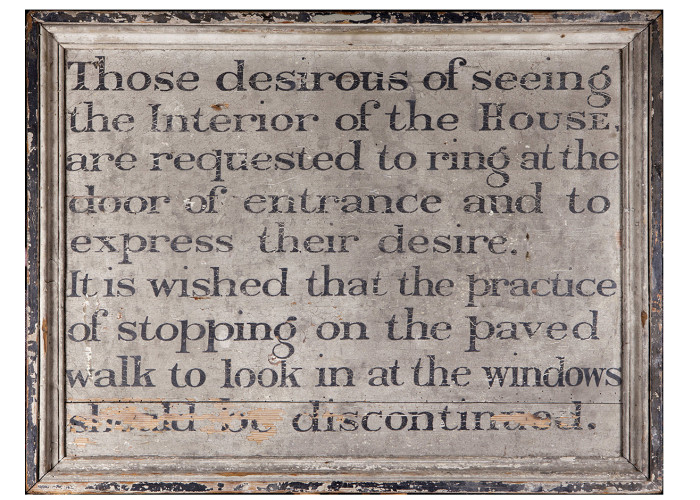Sign for Rude Tourists Erected by Duke of Wellington
This sign was put up outside the Duke of Wellington’s stately home, Stratfield Saye. After the Battle of Waterloo, the Duke became one of the most famous men in Europe, and sight-seers flocked to catch sight of him at his several residences. The sign demonstrates the British public’s fascination with the victor of Waterloo.
In an age before the National Trust and English Heritage this sign also points to a public appetite for visiting grand houses. In Pride and Prejudice, it will be remembered, Lizzie Bennett’s aunt and uncle were keen to take her on their speculative visit to see Mr Darcy’s Pemberley in Derbyshire.
Stratfield Saye in north Hampshire was bought for the Duke by the nation in 1817 for £263,000. The original intention was to demolish the house to make way for a Waterloo Palace, one that would rival Blenheim. Wellington eventually contented himself with improving the relatively modest house whilst adding to the estate. By the time he died it approached 15,000 acres. Would-be visitors, however, were unlikely to see him, whether or not they peered through his windows. Wellington was only regularly at Stratfield Saye during the winter months – and even then often away hunting. When parliament was in session he was more likely to be found at his London home, Apsley House, on Hyde Park Corner. His favourite home, however, from the time that he became Lord Warden of the Cinque Ports in 1828, was Walmer Castle in Kent.
The sign at Stratfield Saye might well be seen as evidence both of the Duke’s brusqueness and his disdain for the public. But can we blame him in his desire for privacy? [Moreover, he was not actually refusing the public a window on his life; merely asking that they observe certain niceties. Indeed, he was more generous in his reaction to unsolicited visitors than some. Another Hampshire man, William Edward Nightingale, put up a sign which pointedly warned trespassers to stay away from his Embley Park estate when his daughter Florence became famous shortly after Wellington’s death.]
-
Curatorial info
- Originating Museum: Stratfield Saye
- Production Date: 1840s?
- Material: Painted wood
- Size: 72.5cm x 56cm
-
Use this image
- Rights Holder: Stratfield Saye Preservation Trust
- License Type: All Rights Reserved
Find it here
This object is in the collection of Stratfield Saye






